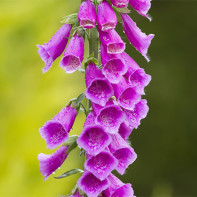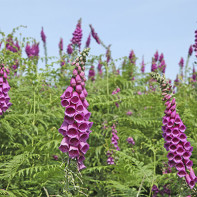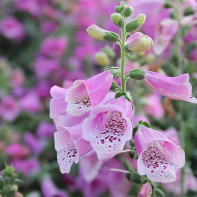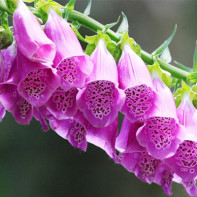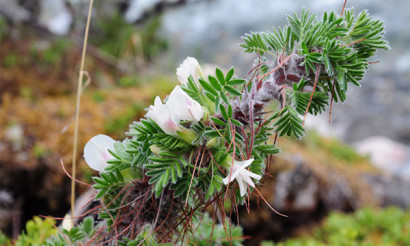Digitalis: medicinal properties and contraindications
In Latin, the name digitalis sounds like “Digitalis purpureae”. The first word in this case is translated as “finger”, “thimble” or “ring”, and the second describes the color of the flowers, that is, they are characterized by a mixture of purple and red. For such a special form, the plant is popularly called the forest bell. Previously, when medicine was not so developed, doctors could not reveal the full chemical composition of the culture and correctly determine the dosage, so patients often died during treatment with this herb. Based on this, digitalis is also called the witch’s flower or witch’s thimbles.
Since the XVIII century, this plant began to be used in the field of medicine. It was during this period that the medicinal qualities of digitalis were revealed by official sciences. Specialists considered this culture to be one of the most effective therapy products of those times.
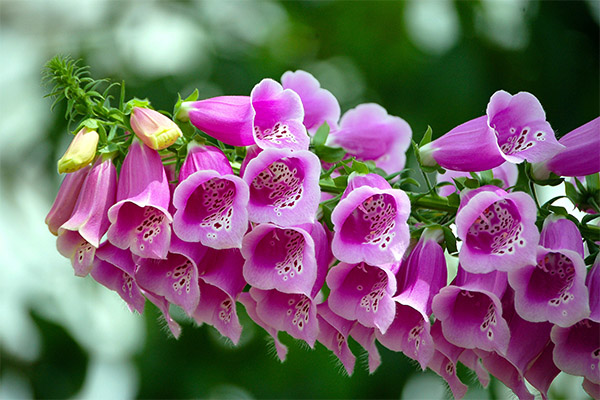
In the middle of the XIX century, grass began to be used first by the Russian, then the Soviet pharmaceutical industry. There are several main types that are most often used in the manufacture of drugs characterized by various therapeutic properties.
Leaves of grass are the main parts that act as plant materials. Typically, they are collected in the first year of digitalis growth, when it reaches the desired size. It is in this part of the plant that the maximum concentration of useful components is concentrated. To a greater extent, the useful characteristics of this flower are due to the presence in it of digoxin and lanagoside C. These components are effective in combating diseases of the cardiovascular system.
Ancient healers using this herbal product treated epilepsy, dropsy. It is also known that the herb has long been used in informal medicine as a painkiller for dermatological pathologies of an inflammatory nature. As for internal inflammation, bleeding, the use of a flower was prohibited.
Chemical composition
Digitalis is pretty well understood today. It is noted that not all varieties have healing properties. Glycosides, saponins, flavonoids, and other useful components were found in the leaves, flowers, and stems of some species.
Digitalis purpurea is an incredibly beautiful plant that can be used for decorative purposes. But despite this, in this variety, scientists have found more than six dozen glycosides that can be used to treat heart disease. Among them are primary glycosides A and B, which, after drying and during storage, are transformed into secondary glycosides. They are used for the production of appropriate drugs.
The main drugs in this case are “digitoxin” and “hygoxin”. Both are indicated for the treatment of tachycardia and heart failure. The difference between them is that the first product is characterized by a high degree of cumulation, while the second product has a lower level of toxicity, therefore, cumulation is also less.
The leaves of the herb also contain acetyldigitoxin, which is used for tachycardia and arrhythmia caused against its background. This substance is able to be rapidly absorbed, but at the same time accumulate less in the body. In addition, a high concentration of saponins, choline and flavonoids was noted in the leaves of the plant.
How it looks and where it grows
As noted above, there are many varieties of forest bell that grow in different parts of the globe.These are Africa, Europe, Asia and the CIS countries. Digitalis is rare in the wild, so the plant is cultivated for medicinal use.
Digitalis is a two-year and perennial grass, depending on the variety. In the Mediterranean regions, it grows in the form of a bush, has a rather high stem, which reaches 150 cm. The leaves are highly pubescent, dark green in color. Veins clearly stand out on them.
Externally, digitalis purple is different in the first and second year of life. Initially, basal leaves are formed on it, the length of which is 20–25 cm. As they grow, unbranched stems with leaves develop. The flowers are quite large, the color is purple-red. Flowering begins in the summer and continues until the beginning of autumn.
The digitalis large-flowered has almost the same description as the purple fellow. The leaves of this species have the same structure, are painted in a light green color, the stems are pubescent. Culture begins to bloom in early July. Grass flowers have a yellowish tint.
The digitalis woolly has flowers, outside painted whitish-yellow in color, and inside with lilac veins.
Kinds
There are several varieties of plants that differ in stem height, flower color, corolla structure. In addition, each species differs in the shape and size of the leaves, the venation variant and the degree of pubescence of the leaf plate.
- Digitalis yellow is most commonly found in central and southwestern Europe. This crop is a perennial grass that can be up to 1 m high. It has smooth leaves and stems. It is characterized by saturated yellow flowers, which was the reason for the appearance of such a name. Yellow digitalis is widely used for decorative purposes. As for the use in informal medicine, there is practically no mention of this.
- Digitalis purpurea is one of the most common and effective varieties of this plant. This variety has an upright stalk of cylindrical shape. Also, the grass is characterized by beautiful, large flowers of purple color. The height of such a forest bell varies between 1–1.2 m. It grows mainly in European regions and in the Mediterranean. It is popular in traditional medicine and in the field of pharmacology. From the leaves, drugs are obtained in the pharmaceutical industry.
- Decoctions and infusions obtained on the basis of such a product provide quick healing of wounds and improve the patient's condition with hysteria. Purple digitalis is also characterized by the presence of a number of mineral elements, organic acids, flavonoids, various vitamins and other valuable compounds.
- The most unprepossessing representative of this family is digitalis woolly. This species has smaller flowers compared to other varieties. But, despite this, raw materials are widely used in medicine. Due to the fact that acetyldigitoxin and celanide were found in the composition of such a plant, the terrestrial parts of the woolly digitalis are used in the manufacture of medicines that ensure the normal functioning of the heart muscle. The greatest healing power is characteristic of the leaves of this plant. In folk medicine, raw materials are used in the treatment of cardiac pathologies, as well as ascites.
- The large-flowered digitalis is presented in the form of a perennial herbaceous plant with a height of not more than 1 m. It is characterized by a short root and a straight stem. The leaves are light green in color, about 20 cm long. This species is included in the list of the five most commonly used varieties in the medical field. Based on this medicinal herb, a number of cardiological medicines are obtained. It is often used to eliminate circulatory failure. Many medicinal substances were found in the leaves of such a medicinal herb, including cardiac glycosides, minerals, tannins, saponins.To obtain raw materials, it is recommended to collect leaves from the end of August to the beginning of September.
- Digitalis perennial is a variety that is both a raw material for creating medicines and an ornamental plant. Perennial specimens are characterized by a unique complex of substances useful for human health, which for several centuries allows them to be used for therapeutic purposes. The grass is unpretentious in leaving, normally tolerates a drop in temperature and can grow with insufficient sunlight.
Collection and storage
Digitalis are the raw materials of digitalis leaves. In the first year of growth, rosette leaves are used for these purposes, and you can collect them up to three times during the summer period. In the second year of life, immediately after flowering, stem leaves gather. It is important to start preparing raw materials during this period, since violation of these terms leads to the fact that the pharmacological properties of the herb are reduced. In this case, the leaves should be without stalk, since they slow down the drying process and no biologically active elements are concentrated in them.
The collection of raw materials should be carried out in dry, sunny weather, since it is in the light that the intensity of glycoside accumulation increases. It should be remembered that you need to collect digitalis during the flowering period. If the plant is grown on two-year plantations and the grass of the first year of life breaks down, it is important to protect the root of the culture from damage.
The therapeutic characteristics of digitalis can be reduced if the medicinal plant material is not properly stored. For this reason, preforms should be well packaged so that valuable components are preserved. Whole grass should be kept in a dry and dark place. Every year it is necessary to control the biological activity of the plant.
How to grow digitalis
You can easily grow a forest bell from seeds. Such a plant does not need daily processing, but along with this it gives good shoots. At the same time, even winter sowing of crops can be performed, but it can be done in late spring or early summer. First you need to loosen the soil, mark the rows at a distance of 35–40 cm, and then sow the seeds densely, and it’s not worth planting them deeply, you just need to lightly sprinkle with sand. To keep moisture, it is recommended to lay agrofibre on top.
After 10-14 days, seedlings appear, which must be carefully watered and protected from sunlight. At the same stage, thinning is performed so that at least 10 cm remains between the sockets.
At the end of summer, seedlings are transferred to a permanent place. In this case, sprouts should be planted at a distance of 25 cm from each other. In winter, seedlings should be covered with dry leaves. Digitalis usually blooms in the second year of life.
This type of plant does not prefer excess moisture and loves well-lit areas.
The healing properties of digitalis
Digitalis preparations are characterized by antibacterial, diuretic, sedative, restorative and immunostimulating qualities.
- Means based on this plant provide normalization of the cardiovascular system, lower blood pressure, increase diuresis, eliminate swelling, shortness of breath and blueness, stabilize blood circulation in tissues, and normalize tissue respiration. In addition, this product provides the strengthening of the body's defenses.
- Digitalis purpurea is used in the treatment of insomnia, headache, heart disease and central nervous system. Before using medicinal compounds with a forest bell, it is necessary to study the instructions for use (even if the medication was prescribed by a doctor). This is due to the fact that digitalis has a number of contraindications that can cause serious health problems.
- In addition, drugs based on this culture are prescribed in the treatment of acute and chronic forms of heart failure, arrhythmias, congenital and acquired heart defects. Digitalis will help to cope with hypertension, that is, it provides a decrease in blood pressure. Also, with the help of this culture, it is possible to eliminate ophthalmic diseases, namely to reduce eye pain with migraines and lower intraocular pressure.
- Since digitalis has a diuretic and decongestant effect, it can be used to treat kidney pathologies. The plant in this case will improve the excretion of fluid from the body. Pathologies of the lungs can also be treated with digitalis, because it can reduce shortness of breath and improve the flow of oxygen to the cells.
- Thanks to the healing properties of digitalis, with its help it is possible to cure flickering arrhythmia. With heart failure and epilepsy, medicines based on this herb are also often prescribed.
- An ointment based on a forest bell will help eliminate pain with dermatological inflammation. Diseases that are of an infectious origin can also be treated with digitalis-based agents.
Digitalis in folk medicine
Digitalis is characterized by a number of healing properties, which allows it to be used in the treatment of various diseases.

- So, with pathologies of the heart, you can prepare an infusion based on dried raw materials, which are previously crushed. In this case, it is necessary to measure about 1 g of leaves and pour them with a glass of water. Infusion should last 10-12 hours. Ready solution to drink 2 times a day for 5 ml, regardless of food intake.
- For the treatment of pathologies of the cardiovascular system, digitalis can also be used in powder form. Such a product does not affect the activity of the liver and kidneys. It is enough for an adult to take 0.1 g of powder twice a day. Such a medicine must be stored in a dish of dark glass, which is also hermetically sealed.
- From the leaves of digitalis, you can prepare a decoction that will help normalize the activity of the heart. To do this, pour 20 g of dry raw material into 600 ml of boiling water and boil the composition until the volume of liquid in the dishes decreases by approximately 200 ml. Then cool the solution and pass through the filter. The medicinal composition should be taken 15 ml per day. If necessary, in the case of a severe course of pathology, a specialist can change the dosage.
- With hypertension, digitalis infusion helps. To prepare it, you need 1 g of dried leaves pour 200 ml of boiled, slightly cooled water. Insist the product for 30-40 minutes. Ready to take 1 tbsp. several times a day. This composition is used for high blood pressure only with the permission of the attending physician.
- Digitalis can treat cuts and burns, as it has the ability to heal minor wounds and injuries resulting from thermal burns. In such cases, you need to prepare a powder from dried raw materials, which then pour onto a damaged surface. After treating the skin with this composition, use thin gauze dressings so that the dermis can breathe. To heal wounds, you can also do lotions. To do this, it is necessary to impregnate the fabric in a decoction of leaves and apply to damaged areas for a quarter of an hour.
- In case of nervous diseases, medicinal plant material is used to prepare the drug. In this case, alcohol tincture is being prepared. To do this, place 20 g of raw materials in a dark glass container and pour a cup of wine alcohol. After that, seal the container, and then send it to a dark and warm place. Infusion should last 7 days.It is important to shake the contents of the bottle periodically. A single dose should not exceed 30 drops of the resulting composition.
- Alcohol tincture is also used for nerve attacks. Prepare the medicine as follows. In a bottle made of dark glass, pour 20 g of dried leaves, then pour them with 50 ml of ethyl alcohol. Infuse the mixture for a week in a dark place, regularly shaking the container. After the specified time, drain the liquid. Received tincture to take 15 drops. In this case, the specified amount should be diluted in 50 ml of boiled water.
- In case of arrhythmia, digitalis water infusion is prepared. To obtain a medicinal composition, you should take 1 g of dry, pre-crushed raw materials and pour it with 180 ml of hot, boiled water. Then keep the mixture under the lid for 60 minutes. After this, filter the liquid and take 3 times a day for 1 tsp. If the medicine is prepared for a child, take 2 times less medicinal plant material for the same amount of water. Children can take such an infusion only after 12 years.
- If you grind the dry digitalis leaves in a coffee grinder, you get a powder that can be used for a heart attack. It is necessary to take such a composition inside of 0.1 g no more than 4 times a day. Keep the finished powder in a dry, sealed container. The duration of treatment should not exceed 10-12 days.
Types of healing compounds
To prepare various healing compounds, you can use the powder obtained from digitalis leaves. It is very simple to prepare it, you just need to cut off the ground part of the grass, dry it for several days under the sun, and then grind the dry mass to form a powdery consistency.
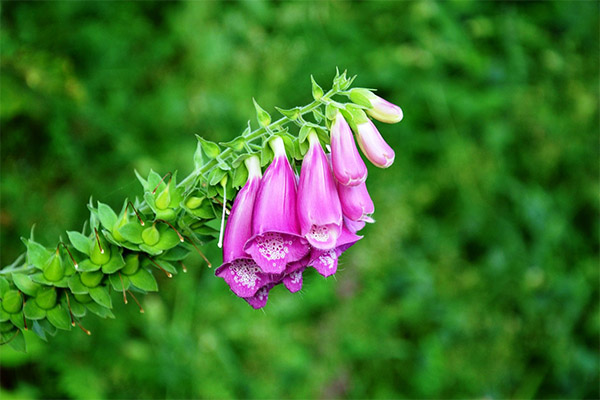
It should be remembered that in order to obtain high-quality medicinal raw materials, the plant must be collected far from roads. Before drying, rinse digitalis thoroughly.
Infusion
To prepare this composition, 3 g of dry grass should be poured with 250 ml of boiling water. The solution is infused for 15 minutes. After that, filter the liquid. Add 1 drop of oil to the amount of medicine received. Take this composition for 1 tbsp. every 3 hours.
Tincture
To get the tincture, you just need to pour 25 g of dry digitalis leaves 60 ml of alcohol. Next, the solution should be infused for a week. Ready-made medicine to take 10 drops every day.
Decoction
Such a composition based on digitalis helps to establish the activity of the heart. To prepare it, you need to fill in 20 g of plant material with three glasses of boiling water. Cook the resulting mixture until the volume of liquid decreases by one glass. This broth should cool, after which it must be filtered. Take the medicine for 2 tbsp. 1 per day.
Digitalis Pharmacy
Digitalis is characterized by a cardiotonic effect, which is explained by the presence of cardiac glycosides in its composition. With internal administration, the drug begins to act after some time. These glycosides are slowly eliminated from the body, so they can accumulate in the body. This cumulative effect is more pronounced in digitoxin and less pronounced in digoxin.
Digitalis is used to treat heart failure, which is characterized by stagnation in the pulmonary circulation and the pulmonary circulation. Also, drugs of this group are indicated for valve disease, myocardial dystrophy.
The therapeutic effect is expressed in the fact that the minute volume of blood increases, blood pressure decreases, the amount of circulating blood decreases, the blood flow speeds up, the size of the heart decreases, diuresis rises and edema decreases.
During therapy, it is important to monitor CCC and the general condition of the patient.It must be borne in mind that in some patients, individual hypersensitivity to certain components of the drugs may occur. If side effects develop, treatment is suspended. Treatment with digitalis-based medicinal formulations is usually done by prescribing maximum doses in the first few days. This is done in order to achieve a full therapeutic effect. After that, maintenance doses are prescribed, which are determined by the level of excretion of the main active glycoside substances. If the drugs are prescribed intravenously, the product is pre-diluted with a glucose solution.
It should be borne in mind that digitalis-based drugs cannot be used for therapeutic purposes in case of bradycardia, atrioventricular blockade, frequent angina attacks.
The leaves of the forest bell are used for the production of a number of industrial preparations. In this case, the dosage form may be different. From digitalis, tablets, tinctures, capsule preparations, injection solutions are made.
The main drugs of purple digitalis are:
- "Digitoxin." It is a tablet form of digitalis. This medicine is intended for the treatment of heart failure, hypertension, heart valve defects, arrhythmias. It is characterized by a high degree of cumulation in the body, it dissolves rather poorly.
- "Gitoxin." It has the same indications as the first drug. However, it differs in that it dissolves better and has a lower level of accumulation in the body. It is usually produced in the form of a white powder.
- Cordigitus. It is a combined drug that contains both of the above compositions. Available in the form of tablets, as well as rectal suppositories. It has a low cumulative effect and good solubility in water.
Contraindications
Despite the fact that digitalis is characterized by many useful qualities, there are still limitations in the application. It is prohibited to use funds based on this medicinal plant if the patient has an elevated level of cholesterol in the coronary arteries, myocardial infarction, or chronic lung diseases. Coronary heart disease, the period of carrying the baby and breastfeeding, infectious diseases, bradyarrhythmia and gastric tachycardia are also restrictions on taking drugs in this group.

Digitalis can be dangerous for the child's body, so it should not be given to children under 12 years of age.
In some cases, there is an increased sensitivity to the substances that make up the grass.
Digitalis poisoning
Very often during the preparation of medicines based on the forest bell at home, people ask themselves whether intoxication can develop as a result of using such a plant product. Before using digitalis for therapeutic purposes, it is important to know that such a culture is toxic if the daily dose is exceeded or more raw materials are used in the preparation of the medicinal composition.
Intoxication with such a plant is manifested by acute pain in the abdomen, which is accompanied by diarrhea. Also in this case, the person will feel sick, while vomiting is frequent and rather painful. In addition, with digitalis poisoning, a dull pulse is observed, it seems that the heart is beating.
Another side effect of exceeding the optimal doses is the appearance of rashes on the skin, which are similar to ordinary irritation. In some cases, cramps occur along with uncontrolled muscle contractions. Perhaps the appearance of hallucinations and dips in memory.
It should be noted that with digitalis intoxication, several symptoms may appear simultaneously.
It is important to consider that in the most critical situations, cardiac arrest occurs.
If even the most minor symptoms are identified, an ambulance team must be called in immediately to receive specialized care. It will not work out on your own.
Toxins, which are concentrated in digitalis, are able to accumulate in the body, resulting in unpleasant consequences.
«Important: all information on the site is provided exclusively in fact-finding purposes. Before applying any recommendations, consult with a profile specialist. Neither the editors nor the authors are liable for any possible harm caused materials. "

